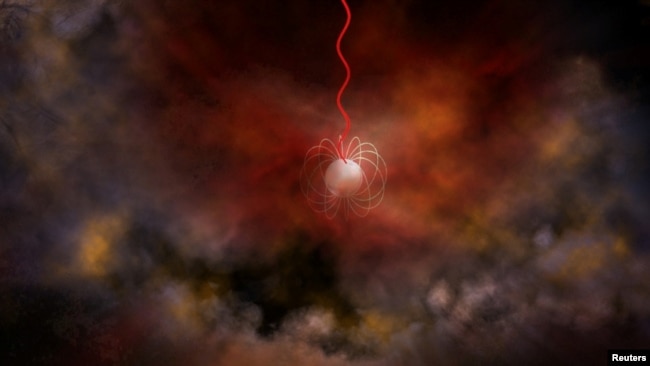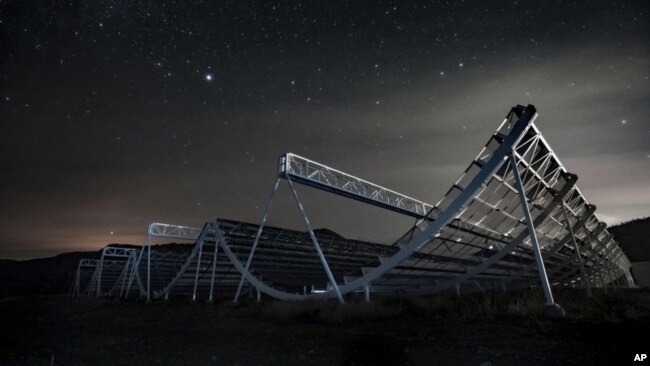銀河からの信号
宇宙のミステリー!!
ロマンを科学で解き明かす!!
全てのことをひととき忘れて、ギャラクシーに思いを馳せましょう!
VOAで英語を学びましょう!!
遥か彼方の銀河から新たな電波信号が発信されていることを発見(和訳)
Scientists Discover New, Unusual Radio Signal from Faraway Galaxy
July 24, 2022
研究者たちは、遠くの銀河から新しい、珍しい電波信号を発見したと発表しました。
この信号は、高速電波バースト、またはFRBとして知られています。この信号は電波のパルスで、私たちの天の川銀河の中や他の場所から来る可能性があると科学者は言っています。
最初のFRBは2007年に発見されました。それ以来、世界各地の大型望遠鏡で何百もの信号が観測されています。
FRBがなぜ発生するのか、天文学者にはよくわかりません。しかし、この信号は中性子星から発生する可能性があると考えられています。中性子星は、より大きな星が重力崩壊した後に形成され、その星の寿命が尽きるときに爆発すると考えられています。
今回のFRBを報告した研究者たちは、この信号が他の観測よりもずっと長く続いたことが珍しいと述べています。ほとんどのFRBは数ミリ秒しか続きません。しかし、今回の信号は最大で3秒、つまり約1,000倍も長く続いたと研究チームは声明で説明しています。
新しいFRBは、2019年12月にカナダ水素強度マッピング実験、CHIME、と呼ばれる電波望遠鏡によって初めて観測されました。この望遠鏡は、カナダ南西部の都市カレデンの近くに設置されています。カナダとアメリカの複数の大学がこのプロジェクトをサポートしています。
CHIMEは、遠方の銀河にある水素ガスが放つ電波を観測するために設計されました。しかし、この望遠鏡はFRBからの信号を拾うのにも適しているという言います。
この信号は、地球から数十億光年離れた遠方の銀河から来たと考えられると科学者らは言います。1光年とは、光が1年間に進む距離で、約9兆キロメートル。
研究者は、今回観測されたFRBは、通常とは違うと言います、なぜなら”心臓の鼓動に似た”連続的なパターンを繰り返しているからです。過去に観測されたほとんどのFRBは、一般的に数ミリ秒の間持続した後、消滅しています。
ダニエレ・ミチリ氏は、マサチューセッツ工科大学(マサチューセッツ州ケンブリッジ)の博士研究員候補です。同大学のカブリ天体物理学・宇宙研究所の研究リーダーとして協力しました。彼によると、望遠鏡が観測したような”周期的な信号”を発するものは、宇宙にはあまり存在しないと言います。
このことから研究チームは、この珍しいFRBはパルサーとマグネターという2種類の中性子星から来たのではないかと考えています。パルサーとは、高速で回転する中性子星です。マグネターとは、非常に強い磁場を持つ中性子星のことです。「この新しい信号は、ステロイドのマグネターかパルサーではないかと我々は考えています。」とミチリ氏は語ります。
この信号がどこから来たのかについては、我々の銀河系で観測されたパルサーやマグネターのデータに基づいて結論が出されました。しかし、研究チームは、この異常なFRBは天の川銀河で観測されたものより100万倍以上明るく見えると指摘しています。なぜこれほどまでに明るくなるのか、科学者らはその理由はわかっていないそうです。
天文学者らは、この信号は、これまでに観測されたどのFRBよりも周期が長く、周期的なパターンが明瞭であると言います。彼らは、この信号の追加観測を希望しています。これにより、この信号がどこから来たのか、また中性子星の一般的な性質についてより深く理解することができるかもしれません。
「この検出は、今まで見たことのない極端な信号の原因は何なのか、そしてこの信号をどのように宇宙を研究するために使うことができるのかという問題を提起しています。」とミチリ氏は述べました。「将来の望遠鏡は、月に何千ものFRBを発見することを約束しており、その時点で、この周期的な信号がもっとたくさん見つかるかもしれません。」
Scientists Discover New, Unusual Radio Signal from Faraway Galaxy
Researchers say they have discovered a new, unusual radio signal from a distant galaxy.
The signal is known as a fast radio burst, or FRB. These signals are pulses of radio waves that scientists say can come from places within our own Milky Way galaxy or others.
The first FRB was discovered in 2007. Since then, hundreds of the signals have been observed by large telescopes in different parts of the world.
Astronomers are not sure what causes FRBs. But they have theorized the signals could be produced by neutron stars. A neutron star is thought to form after the gravitational collapse of a larger star that explodes at the end of its life.
The researchers reporting the latest FRB say it was unusual because the signal lasted much longer than others observed. Most FRBs last only a few milliseconds. But the new signal lasted up to three seconds – about 1,000 timer longer – the team explains in a statement.
The new FRB was first observed in December 2019 by a radio telescope called the Canadian Hydrogen Intensity Mapping Experiment, or CHIME. The telescope sits near the southwestern Canadian city of Kaleden. Several Canadian and American universities support the project.
CHIME was designed to observe radio waves given off by hydrogen gas in distant galaxies. But the telescope’s operators say it is also good at picking up signals from FRBs.
The scientists say they think the signal came from a distant galaxy several billion light years from Earth. A light year is the distance light travels in one year, about nine trillion kilometers.
The researchers said the newly observed FRB was also unusual because it appeared to repeat a continuous pattern, “similar to a beating heart.” Most FRBs observed in the past generally lasted for a few milliseconds before disappearing.
Daniele Michilli is a postdoctoral candidate at the Massachusetts Institute of Technology in Cambridge, Massachusetts. He helped lead the research for the university’s Kavli Institute for Astrophysics and Space Research. He says there are not many things in the universe that give off the kind of “periodic signals” the telescope observed.
This led the team to believe that the unusual FRB may have come from two kinds of neutron stars, a pulsar or a magnetar. A pulsar is a fast-spinning neutron star. A magnetar is a neutron star with a very strong magnetic field. “We think this new signal could be a magnetar or pulsar on steroids,” Michilli said.
Their conclusion about where the signal came from was based on data collected on pulsars and magnetars observed in our own galaxy. However, the team noted that the unusual FRB appears to be more than a million times brighter than those observed in the Milky Way. The scientists are not sure why the FRB would be so much brighter.
The astronomers said the new signal is the longest lasting and has the clearest periodic pattern than any FRBs observed before. They are hoping to capture additional observations of the signal. This could help them better understand where it came from and learn more about the general nature of neutron stars.
“This detection raises the question of what could cause this extreme signal that we’ve never seen before, and how we can use this signal to study the universe,” Michilli said. “Future telescopes promise to discover thousands of FRBs a month, and at that point we may find many more of these periodic signals.”
Words in This Story
galaxy – n. a very large group of stars held together in the universe
pulse – n. a short increase in an amount of electricity, light or sound
pattern – n. a regular and repeated way in which something happens
conclusion – n. a reasoned judgment
steroid – n. a drug used for treating injuries and that some athletes use illegally to improve their performance in sports
detect – v. to discover or notice something

